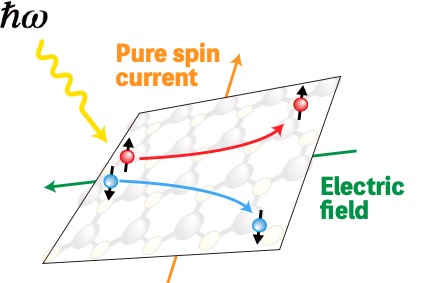若林克法・工学部教授らによる単層NbSe2における光誘起スピン流に関する理論が、米国物理学会誌Physical Review Bに掲載されました
Research on optically induced spin current in monolayer NbSe2 by Professor Katsunori Wakabayashi published in Physical Review B
2021.06.07
論文 Article
若林克法工学部教授と羽原廉氏(理工学研究科先進エネルギーナノ工学専攻1年)が、二次元原子膜物質の一つである単層NbSe2において、光誘起によるスピン流の生成が可能であることを理論的に提案致しました。この研究成果は、2021年4月20日付で、米国物理学会誌 Physical Review Bに掲載されました。
炭素原子だけからなる一原子層物質であるグラフェンの発見以降、一原子から数原子分の厚みしか持たない原子膜・分子膜物質の研究が盛んに行われている。なかでも単層NbSe2は、金属的性質をもつす2次元遷移金属ダイカルコゲナイドとして知られている。その結晶構造と強い原子的なスピン軌道相互作用(SOC)により、単層NbSe2はイジング型SOCを有することが期待されている。本研究では、Nb原子の内、d軌道のみに着目した有効強束縛模型を構築し、この模型に基づく単層NbSe2のスピンに依存する光学的伝導度を、久保公式を用いて数値計算した。その結果、光を照射によって単層NbSe2に純スピン流が生成させることが可能であることを示した。また、その光誘起スピン流は温度に対して強固であり、室温でさえ効率よくスピン流を生成することができるだけなく、可視および紫外光領域で効率よく応答することを見出した。
本研究の成果によって、可視および紫外光を利用したスピン流ハーベスティングなどの光スピントロニクスデバイスの設計や応用が期待される。
炭素原子だけからなる一原子層物質であるグラフェンの発見以降、一原子から数原子分の厚みしか持たない原子膜・分子膜物質の研究が盛んに行われている。なかでも単層NbSe2は、金属的性質をもつす2次元遷移金属ダイカルコゲナイドとして知られている。その結晶構造と強い原子的なスピン軌道相互作用(SOC)により、単層NbSe2はイジング型SOCを有することが期待されている。本研究では、Nb原子の内、d軌道のみに着目した有効強束縛模型を構築し、この模型に基づく単層NbSe2のスピンに依存する光学的伝導度を、久保公式を用いて数値計算した。その結果、光を照射によって単層NbSe2に純スピン流が生成させることが可能であることを示した。また、その光誘起スピン流は温度に対して強固であり、室温でさえ効率よくスピン流を生成することができるだけなく、可視および紫外光領域で効率よく応答することを見出した。
本研究の成果によって、可視および紫外光を利用したスピン流ハーベスティングなどの光スピントロニクスデバイスの設計や応用が期待される。
雑誌名: Physical Review B
論文タイトル: Optically induced spin current in monolayer NbSe2
著者: Ren Habara (羽原 廉) and Katsunori Wakabayashi (若林 克法)
DOI: 10.1103/PhysRevB.103.L161410
On 20 April, 2021, the theory of optical induced spin current in monolayer NbSe2 conducted by Prof. Katsunori Wakabayashi, School of Engineering, has been published in Physical Review B.
Transition-metal dichalcogenide (TMDC) is a new class of two-dimensional (2D) electronic systems and provides a platform to design the new functional opt-electronic devices. Monolayer NbSe2 is known to show metallic behavior with superconducting phase transition at low temperatures. Owing to the strong atomic spin-orbit coupling (SOC) field, NbSe2 possesses the Ising-type SOC, i.e., an effective Zeeman field that locks electron spin to out-of-plane directions by in-plane momentums.
This article provides numerical results of the spin-dependent optical conductivity of NbSe2 calculated using Kubo formula based on an effective tight-binding model (TBM). It is shown that the up- and down-spin have opposite sign of Hall current, so the pure spin Hall current can be generated in monolayer NbSe2 under light irradiation. The origin of spin current is owing to the topological nature of monolayer NbSe2, i.e., finite spin Berry curvature. The optically induced spin Hall current can be enhanced by the electron doping and persists even at room temperature. Our results will serve to design opt-spintronics devices such as spin current harvesting by light irradiation based on 2D materials. Our results will serve to design the opto-spintronics devices based on 2D Materials.
Transition-metal dichalcogenide (TMDC) is a new class of two-dimensional (2D) electronic systems and provides a platform to design the new functional opt-electronic devices. Monolayer NbSe2 is known to show metallic behavior with superconducting phase transition at low temperatures. Owing to the strong atomic spin-orbit coupling (SOC) field, NbSe2 possesses the Ising-type SOC, i.e., an effective Zeeman field that locks electron spin to out-of-plane directions by in-plane momentums.
This article provides numerical results of the spin-dependent optical conductivity of NbSe2 calculated using Kubo formula based on an effective tight-binding model (TBM). It is shown that the up- and down-spin have opposite sign of Hall current, so the pure spin Hall current can be generated in monolayer NbSe2 under light irradiation. The origin of spin current is owing to the topological nature of monolayer NbSe2, i.e., finite spin Berry curvature. The optically induced spin Hall current can be enhanced by the electron doping and persists even at room temperature. Our results will serve to design opt-spintronics devices such as spin current harvesting by light irradiation based on 2D materials. Our results will serve to design the opto-spintronics devices based on 2D Materials.
Journal name: Physical Review B
Article title: Optically induced spin current in monolayer NbSe2
Author(s): Ren Habara and Katsunori Wakabayashi
DOI: 10.1103/PhysRevB.103.L161410


関連記事
- 2021.09.16
論文 Article
共同研究 Collaborative Research
-
若林克法・工学部教授らによる論文「Thickness-dependent Raman active modes of SnS thin films」が、AIP Advances誌に掲載され、Featured ArticleおよびScilightに選出されました
Research on Thickness-dependent Raman active modes of SnS thin films by Prof. Katsunori Wakabayashi (School of Engineering) has been published in AIP Advances and selected as Featured Article and Scilight(Science Highlight).
back
